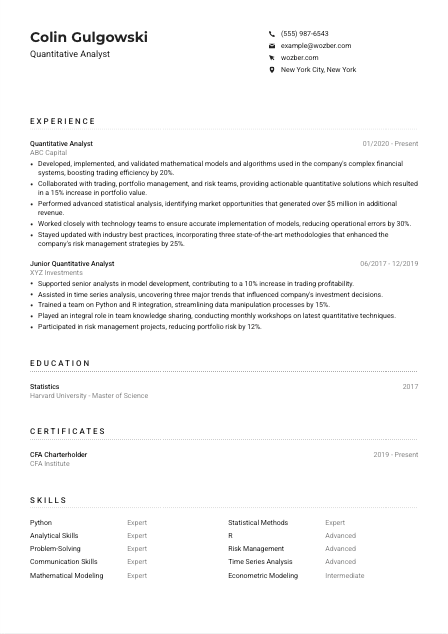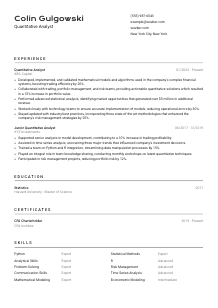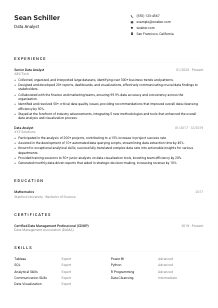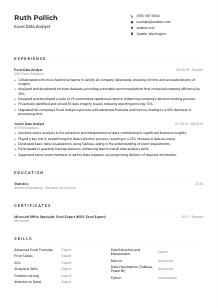Quantitative Analyst CV Example
Crunching numbers, but your CV doesn't add up? Explore this Quantitative Analyst CV example, calculated using Wozber free CV builder. See how efficiently you can present your data-driven expertise to fit the job equation, creating a career narrative as precise as your statistical models!

How to write a Quantitative Analyst CV?
Embarking on the journey to land a Quantitative Analyst position? You're about to navigate through the detailed art of tailoring your CV. With precise analysis, just like in your profession, this guide, powered by the Wozber free CV builder, will showcase how to transform your CV into a captivating narrative that speaks volumes to hiring managers. Dive into the math behind the perfect CV and let's decode the equation together.
Personal Details
The Personal Details section is your CV's handshake. It's straightforward but pivotal, setting the stage for the depth of your expertise to come. For a Quantitative Analyst position, it's all about precision, clarity, and relevance. Follow these steps to ensure your introduction aligns with the expectations of the analytical world.
1. Brand Yourself
Your name is the headline of your professional story. Ensure it's prominently displayed, clear, and in a font size that commands attention without overshadowing the content beneath.
2. Align Your Title
Including the job title you're aiming for right below your name serves a double purpose: it makes your goal clear and helps with ATS optimisation. "Quantitative Analyst" as your title signals an immediate relevance to the role.
3. Essential Contact Info
Focus on providing your most current and professional contact details. A phone number without errors and an email that is simple yet professional (think firstname.lastname@domain.com) are must-haves. Remember, your email address also reflects your professional image.
4. Location Matters
Since the job description specifies New York City, include it to demonstrate your alignment with this requirement. It subtly communicates your readiness and availability for the position.
5. Professional Links
Adding a LinkedIn profile or a personal website can set you apart. Ensure they are polished and mirror your CV's information. This is particularly important in analytical fields, where your digital presence can also showcase your precision and attention to detail.
Takeaway
Your Personal Details section is more than just an introduction. It's the first test of your ability to present information clearly and accurately. Get it right, and you've made a strong first impression.





Experience
The Experience section is where you get to demonstrate your analytical prowess and how your past roles prepare you for the Quantitative Analyst role. It's time to quantify your achievements and present your experience through the lens of data analysis and financial acumen.
- Developed, implemented, and validated mathematical models and algorithms used in the company's complex financial systems, boosting trading efficiency by 20%.
- Collaborated with trading, portfolio management, and risk teams, providing actionable quantitative solutions which resulted in a 15% increase in portfolio value.
- Performed advanced statistical analysis, identifying market opportunities that generated over $5 million in additional revenue.
- Worked closely with technology teams to ensure accurate implementation of models, reducing operational errors by 30%.
- Stayed updated with industry best practices, incorporating three state‑of‑the‑art methodologies that enhanced the company's risk management strategies by 25%.
- Supported senior analysts in model development, contributing to a 10% increase in trading profitability.
- Assisted in time series analysis, uncovering three major trends that influenced company's investment decisions.
- Trained a team on Python and R integration, streamlining data manipulation processes by 15%.
- Played an integral role in team knowledge sharing, conducting monthly workshops on latest quantitative techniques.
- Participated in risk management projects, reducing portfolio risk by 12%.
1. Dissect the Job Description
Before you pen down anything, closely analyze the job description. Identify keywords and responsibilities such as 'developed mathematical models,' 'performed statistical analysis,' and ensure these are mirrored in your CV with relevant examples.
2. Presentation is Key
List your experiences in reverse chronological order. For each role, prominently state your title, the name of the company, and the period you worked there. This clarity is essential for the hiring manager to trace your professional journey.
3. Achievements that Count
Focus on achievements that directly correspond with the job requirements. Use statements like 'Developed and validated financial models, increasing trading efficiency by 20%', to highlight your direct impact.
4. Back it up with Numbers
Quantifying your contributions is critical in a Quantitative Analyst CV. Whether it's by percentage increase in efficiency, revenue generated, or reduction in errors, these figures catch the eye and provide a tangible measure of your impact.
5. Spotlight on Relevance
Every line in this section should scream Quantitative Analysis. Irrelevant experiences might dilute the focus of your CV. Stick to what amplifies your fit for the role.
Takeaway
The Experience section is your empirical evidence. It not only displays your qualifications but also quantifies your contributions, proving your value as a candidate. Let each bullet point underscore your suitability for the Quantitative Analyst position. And remember, Wozber's free CV builder can ensure this section is ATS-compliant, maximizing your visibility.
Education
For a Quantitative Analyst, the Education section isn't just about listing degrees; it's about showcasing a foundation that has prepared you for the complexities of financial analysis and modeling. This part plays a crucial role in establishing your theoretical grounding.
1. Identify Requirements
The job description calls for a Master's or Ph.D. in a quantitative field - make sure your highest degree is listed first, accurately reflecting the requirement.
2. Clear Structure
Maintain a clean and straightforward layout: degree, field of study, institution, and graduation year. This layout ensures the information is easily accessible at a glance.
3. Match with Job Specification
Explicitly align your degrees to the ones mentioned in the job requirements. If you hold a Master of Science in Statistics, for example, ensure it's clearly stated.
4. Pertinent Courses
If your degree encompasses a broad range of courses, highlighting those directly relevant to quantitative analysis, like econometrics or advanced statistics, can further underline your suitability.
5. Significant Achievements
For roles requiring intensive expertise, including relevant academic accolades, research, or projects, can bolster your profile. Remember, relevancy is key – focus on what strengthens your candidacy for a Quantitative Analyst position.
Takeaway
Education forms the backbone of your expertise in quantitative analysis. Present it effectively, making it easy for hiring managers to see how your academic background aligns with the role's requirements. Utilizing an ATS-friendly CV format from Wozber ensures your educational credentials are presented in a manner that's both appealing to hiring managers and compliant with ATS.
Certificates
In the ever-evolving field of quantitative analysis, staying abreast with the latest methodologies and software is crucial. Certificates can highlight your commitment to continuous learning and expertise in specific areas relevant to a Quantitative Analyst.
1. Job Requirements Review
Begin by zeroing in on any explicit certifications mentioned in the job posting. In cases where certifications are not specified, prioritize those that are widely recognized in the field of quantitative analysis.
2. Relevance Over Quantity
Instead of listing all your certifications, select those that strengthen your application for the Quantitative Analyst role. For instance, a Certificate in Data Analysis or Advanced Statistical Methods is directly applicable.
3. Date Transparency
Including the dates of certification can be beneficial, especially for programs that are continuously updated to keep pace with the industry, signaling to the employer that you are up-to-date with current practices.
4. Continuous Learning
The financial industry doesn't stand still, and neither should you. Emphasize your commitment to professional growth by pursuing and listing new certifications relevant to quantitative analysis.
Takeaway
Certifications are not just credentials; they are a testament to your dedication to mastering your craft. Highlight those that make you a more compelling candidate for the Quantitative Analyst role. Lean on Wozber's free CV builder to ensure these certifications are presented in an ATS-friendly format, ready for both human eyes and ATS.
Skills
The Skills section is essentially your professional arsenal. For a Quantitative Analyst, this goes beyond software proficiency to include analytical methodologies and collaborative competencies. Let's map out how to align this section with the job's demands.
1. Extract and Match
Carefully read the job description, identifying both the explicitly required skills and those implied. Directly match these with your own set of skills, focusing on analytical tools, programming languages (like Python or R), and methodologies relevant to quantitative analysis.
2. Prioritize and Organize
Highlight your most pertinent skills first. An ATS-compliant CV benefits from this organized approach, as it aligns with the keyword prioritization that ATS systems and hiring managers look for.
3. Proof of Competence
Where possible, back up your skills with specific achievements or experiences that demonstrate your proficiency. 'Expert in Python' becomes even stronger when followed by 'applied to create predictive models that increased trading efficiency.'
Takeaway
Your skills are a silent yet powerful testament to your candidacy; make them count. Listing them in a clear, structured manner not only aids in ATS optimisation but also paints a compelling picture of your capabilities. Utilize an ATS-friendly CV template from Wozber to ensure this crucial section gets the attention it deserves.
Languages
In a global financial market, linguistic abilities can be an unexpected asset. For Quantitative Analyst roles, especially those with an international scope, showcasing your language skills can demonstrate a broader communication capability.
1. Review Language Requirements
First, assess if the job explicitly requires or prefers additional languages. For roles centered within a specific geographic area, fluency in the regional language could be crucial.
2. Front and Center
If the job description highlights a language requirement, such as English fluency, ensure this is prominently displayed in your languages section.
3. Additional Linguistic Skills
Including other languages you are proficient in can differentiate you, especially in roles with potential for international collaboration or reports. Each additional language is a testament to your adaptability and global mindset.
4. Honest Proficiency Levels
Clearly indicate your level of proficiency for each language. Candid representation avoids misunderstandings and sets clear expectations.
5. Consider the Role's Global Aspect
For Quantitative Analyst roles with an international dimension, being multilingual could provide a distinct advantage. If applicable, lean into this strength.
Takeaway
Languages can subtly enhance your CV, adding depth to your profile and opening doors to international opportunities. Present them accurately to reflect your true capabilities and potential contributions as a Quantitative Analyst.
Summary
Your summary is the compelling preface to your professional story. For a Quantitative Analyst, it's about striking the perfect balance between showcasing your analytical expertise and your ability to translate data into actionable insights.
1. Capture the Essence
Draw from the job description to highlight your matching expertise right off the bat. A sentence like, 'Quantitative Analyst with over 4 years of experience in developing advanced mathematical models...' immediately aligns your profile with the employer's needs.
2. Detail Your Impact
Mention key skills and significant achievements early in your summary. Illustrate your capacity to drive results, such as enhanced portfolio value or optimised trading strategies, directly reflecting the responsibilities outlined in the job description.
3. Concise Power
A potent summary is brief but powerful. It's not about providing everything but about providing the right things. Focus on 3-5 impactful lines that succinctly broadcast your qualifications and potential value to the team.
4. A Personal Touch
Inject a slight personal touch by mentioning your commitment to ongoing learning or collaboration within teams. This adds dimension to your professional persona, making you more relatable.
Takeaway
A well-crafted summary sets the tone for your CV, highlighting not just what you've achieved but what you're capable of achieving in a new role. Remember, every word counts, so make each one work for you. Leverage Wozber's ATS CV scanner to ensure your summary—and the rest of your CV—is optimised for the role you're targeting.
Launching Your Quantitative Analyst Journey
Equipped with these in-depth insights, you're now primed to craft a CV that resonates deeply with hiring managers, ticking all the right boxes while showcasing your unique edge. Remember, your CV is more than a document—it's a narrative of your professional journey. Use Wozber's free CV builder, including its ATS-friendly CV templates and ATS CV scanner for keywords optimisation, to ensure your CV is not only seen but remembered. Dive in, and let your expertise in numbers narrate the story of your success.

- Master's or PhD in a quantitative field such as Mathematics, Statistics, Physics, or Engineering.
- Minimum of 3 years professional experience in a quantitative role, preferably in finance or risk management.
- Expert proficiency in programming languages such as Python or R, as well as experience with data manipulation and analysis tools.
- Comprehensive understanding of statistical methods, time series analysis, and econometric modeling.
- Strong analytical, problem-solving, and communication skills with the ability to work collaboratively in a team environment.
- Fluent in English both verbally and in writing.
- Must be located in New York City, New York.
- Develop, implement, and validate mathematical models and algorithms used in complex financial systems.
- Work closely with trading, portfolio management, and risk teams to provide quantitative solutions and insights.
- Perform advanced statistical analysis to identify potential risks and opportunities in the market.
- Collaborate with technology teams to ensure efficient and accurate implementation of models and strategies.
- Stay updated with industry best practices, incorporate state-of-the-art methodologies, and actively participate in team knowledge sharing.















